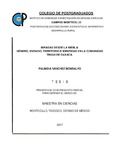| dc.contributor.author | Sánchez Monsalvo, Palmidia | |
| dc.creator | SÁNCHEZ MONSALVO, PALMIDIA; 661727 | |
| dc.date.accessioned | 2019-09-10T13:59:25Z | |
| dc.date.available | 2019-09-10T13:59:25Z | |
| dc.date.issued | 2017-03 | |
| dc.identifier.uri | http://hdl.handle.net/10521/4046 | |
| dc.description | Tesis (Maestría en Ciencias, especialista en Desarrollo Rural).- Colegio de Postgraduados, 2017. | es_MX |
| dc.description.abstract | Esta investigación se centró en el estudio de la territorialidad, a partir de las experiencias que tienen mujeres y hombres en los diferentes espacios del territorio. El objetivo principal fue analizar la relación entre espacio, territorio, identidad étnica y género que se vivencia en el pueblo indígena triqui de San Andrés Chichuaxtla. Para evidenciar este planteamiento, se partió de los postulados de la geografía de género, con el posicionamiento de carácter cualitativo y etnográfico, donde la interpretación de las y los sujetos indígenas fue vital. Se desmenuzaron los vínculos de etnia y género que se establecen entre el espacio doméstico, etnizado y generizado, de “la casa”, comparados con el espacio público, como “la iglesia”, “la tienda” y “el mercado”. Se encontró la existencia, vigencia y reproducción de una construcción culturalgenerizada. Las actividades y relaciones que transcurren en esos espacios y tiempos se relacionan con la división generizada del trabajo y sus significaciones. El entrecruce de tiempo y espacio se anuda de manera compleja por las construcciones y significaciones de género vigentes. También se identificaron los recursos simbólicos de género y etnia del espacio público, encontrando que están relacionados con los procesos de la identidad indígena y la territorialización, para ello se exploraron las ritualidades religiosas, que son el fundamento de la práctica política de la comunalidad. En este sentido, el territorio no sólo es el espacio físico sino también es el cúmulo de referentes simbólicos que las o los sujetos indígenas aprehenden y reproducen para reconstruir y resignificar la vida diaria contemporánea, jalando y refuncionalizando sistemas simbólicos ancestrales, para apropiarse e identificarse con un territorio, dando sentido de pertenencia a un lugar en el mundo. _______________ LOOKING FROM THE FOG: GENDER, SPACE, TERRITORY AND IDENTITY IN THE TRIQUI COMMUNITY OF OAXACA. ABSTRACT: This research focused on the study of territoriality, based on the experiences of women and men in different areas of the territory. The main objective was to analyze the relationship between space, territory, ethnic identity and gender that is experienced in the triqui indigenous people of San Andrés Chichuaxtla. In order to demonstrate this approach, it was based on the postulates of gender geography, with the positioning of a qualitative and ethnographic character, where the interpretation of the indigenous subjects was vital. The ethnical and gender relations established between the domestic, ethnicized and generalized space of "the house", compared with the public space, such as "the church", "the store" and "the market". The existence, validity and reproduction of a generalized cultural construction was found. The activities and relationships that take place in these spaces and times are related to the generalized division of labor and its meanings. The intersection of time and space is knotted in a complex way by the constructions and meanings of gender in force. The symbolic resources of gender and ethnicity of the public space were also identified, finding that they are related to the processes of indigenous identity and territorialization, for which the religious rituals, which are the foundation of the political practice of communality, were explored. In this sense, territory is not only the physical space but also the set of symbolic referents that the indigenous subjects or apprehend and reproduce to reconstruct and reframe contemporary daily life, pulling and refunctionalizing ancestral symbolic systems, to appropriate and identify. | es_MX |
| dc.description.sponsorship | Consejo Nacional de Ciencia y Tecnología (CONACyT). | es_MX |
| dc.format | pdf | es_MX |
| dc.language.iso | spa | es_MX |
| dc.rights.uri | http://creativecommons.org/licenses/by-nc-nd/4.0 | es_MX |
| dc.subject | Género | es_MX |
| dc.subject | Espacio | es_MX |
| dc.subject | Territorio | es_MX |
| dc.subject | Ritualidades religiosas | es_MX |
| dc.subject | Identidad | es_MX |
| dc.subject | Gender | es_MX |
| dc.subject | Space | es_MX |
| dc.subject | Territory | es_MX |
| dc.subject | Religious ritualities | es_MX |
| dc.subject | Identity | es_MX |
| dc.subject | Desarrollo Rural | es_MX |
| dc.subject | Maestría | es_MX |
| dc.subject.classification | CIENCIAS SOCIALES::SOCIOLOGÍA::CAMBIO Y DESARROLLO SOCIAL::EVOLUCIÓN DE LAS SOCIEDADES | es_MX |
| dc.title | Miradas desde la niebla: género, espacio, territorio e identidad en la comunidad Triqui de Oaxaca. | es_MX |
| dc.type | Tesis | es_MX |
| Tesis.contributor.advisor | Zapata Martelo, Emma | |
| Tesis.contributor.advisor | Ayala Carrillo, María del Rosario | |
| Tesis.contributor.advisor | Díaz Cervantes, Rufino | |
| Tesis.date.submitted | 2017-03 | |
| Tesis.date.accesioned | 2017 | |
| Tesis.date.available | 2017 | |
| Tesis.format.mimetype | pdf | es_MX |
| Tesis.format.extent | 8,641 KB | es_MX |
| Tesis.subject.nal | Pueblos indígenas | es_MX |
| Tesis.subject.nal | Indigenous peoples | es_MX |
| Tesis.subject.nal | Conocimiento tradicional | es_MX |
| Tesis.subject.nal | Indigenous knowledge | es_MX |
| Tesis.subject.nal | San Andrés Chicahuaxtla, Putla Guerrero, Oaxaca, México | es_MX |
| Tesis.rights | Acceso abierto | es_MX |
| Articulos.subject.classification | Índigenas de México-Oaxaca | es_MX |
| dc.type.conacyt | masterThesis | es_MX |
| dc.identificator | 5||63||6307||630701 | es_MX |
| dc.contributor.director | ZAPATA MARTELO, EMMA; 2118 | |
| dc.audience | generalPublic | es_MX |


